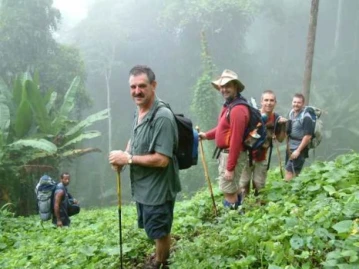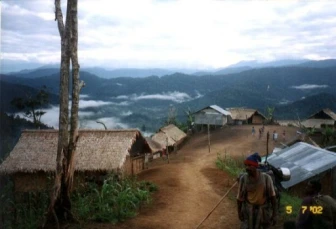Photographs in the Mud celebrates 17-year milestone

It’s 17 years since Dianne Wolfer and Brian Harrison-Lever’s award-winning and acclaimed picture book for older readers was released. And it’s 80 years since the Kokoda Track battles it depicts took place. Published on 30 July 2005 and set in 1942, Photographs in the Mud is told from the point of view of two soldiers, one Australian, the other Japanese, who meet in battle and discover they have more in common than they realise. To mark the occasion, we spoke to Dianne Wolfer about her amazing journey with the book to date.
Where did you get the inspiration to write Photographs in the Mud?
In 2002 I hiked the Kokoda Track with a small group of eight men whose relatives fought there in 1942. My sister worked in Papua New Guinea at the time, organising treks and tours. Her stories about Kokoda had long interested me and I walked the track to research a YA novel (still unpublished). Our small group had knowledgeable guides, which helped manage the challenges of the track.
Not far from the decisive Australian Stand at Isurava (August 1942), we rested at a large tree stump. Our guide told us that a Japanese soldier hid there for days after lying in a ditch with an Australian soldier, who’d died. The Japanese soldier survived the war but said, even as an old man, he’d never forgotten the eyes of that Australian soldier. The mental image of those two men from opposing armies in a ditch together stayed with me and became the climactic scene, brought to life so vividly by Brian Harrison-Lever’s artwork.

Why do you think this is an important story to tell?
Photographs in the Mud is told from both Australian and Japanese perspectives. Its theme is of common humanity and the book has been recognised as an international peace reference and published in Japanese.
As a society I believe it’s important to understand our history, and to honour small moments of empathy during challenging times. Peace remains as elusive as it was when the book was published so many years ago. You can find more about the 1942 incident which sparked this story as well as photos of my trek on my website, via the book link and by adding ‘Kokoda’ to my blog search.

What has the journey of the book been since publication?
The book’s 17-year journey has been amazing. It’s still one of the most visited parts of my website, with hundreds of clicks every year. Schools across Australia, the UK, Japan, Canada and the United States use the story as a literature, history and art reference. Photographs in the Mud has also been the subject of university curriculum and lectures in Canada and the US, and was part of a University of Sydney professorial research project. It has also been serialised the West Australian newspaper. I am grateful Fremantle Press has honoured this story by keeping it in print since 2005.

What’s the best feedback you’ve ever had?
When I sat next to the Vancouver Regional advisor at a SCBWI Conference in LA and he told me his Canadian teaching undergraduates study Photographs in the Mud, I thought I was dreaming.
In Japan, the director of peace museums said the book ‘has touched my heart very deeply and I was moved more than words can say.’ The Japanese edition was published to ‘spread wishes for peace’ in the hope it would reach ‘all children at heart from three through 100 years old.’
Perhaps the most memorable feedback was long ago at Walpole Primary. When a teacher asked the class which man was the hero in the story. Most students nominated the Australian soldier, however one boy challenged this, replying that both men were, because for Japanese readers, Loki was the hero. That wise young man totally ‘got it’.
Why is the book still relevant today?
Sadly, 80 years after the Kokoda campaign, fostering compassion, peaceful resolutions and respect for differences remains a challenge for people across the world. The book’s theme remains as relevant today as when it was published.



